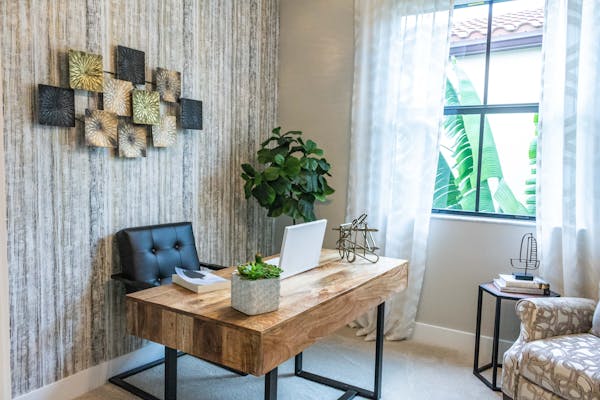DIY Ergonomic Workspace Hacks: 10 Powerful Tips to Improve Your Comfort and Productivity
In today’s fast-paced world of remote work, creating a workspace that promotes both comfort and productivity is essential. Whether you’re working from home full-time, alternating between remote and office work, or simply need an optimized spot for occasional tasks, DIY Ergonomic Workspace Hacks can help you Improve Your Comfort and Productivity. The best part? You don’t need to break the bank on expensive office furniture or gadgets. With a few simple adjustments, you can significantly enhance your workspace, making it more comfortable, supportive, and conducive to better physical well-being and work performance.
An ergonomic workspace is designed to reduce strain on your body by supporting good posture and minimizing physical stress. Long hours at a desk can quickly lead to discomfort in areas like your back, neck, wrists, and eyes. DIY Ergonomic Workspace Hacks allow you to tailor your environment with items you likely already have at home, helping to prevent the aches and pains that often come with poor setup. These simple changes will not only improve your physical comfort but also help you Improve Your Comfort and Productivity, leading to a more efficient and enjoyable workday.
In this article, we’ll explore a variety of simple yet effective DIY Ergonomic Workspace Hacks to optimize your workspace and Improve Your Comfort and Productivity. From adjusting your posture to creatively using household items, these easy-to-implement tips will help you stay productive, reduce strain, and work more comfortably. Whether you’re looking to elevate your monitor, adjust your chair height, or fine-tune your sitting posture, these ergonomic solutions will show you how to enhance your work environment—without the need for costly ergonomic furniture.
For example, a simple adjustment like raising your monitor to eye level can reduce neck strain, while creating a comfortable, supportive seat can alleviate lower back pain. By utilizing common household objects, you can build a workspace that nurtures good posture and supports long-term health. These DIY Ergonomic Workspace Hacks are not only affordable but also easy to implement, making them accessible for anyone looking to Improve Your Comfort and Productivity in their remote work setup.
Why Ergonomics Matter for Remote Work
Setting up an ergonomic workspace is more than just about comfort—it’s essential for maintaining good health and maximizing productivity. When working remotely, you’re likely spending long hours in the same spot. Without the right setup, this can lead to physical discomfort, health issues, and mental fatigue, all of which can hinder your performance. By incorporating DIY Ergonomic Workspace Hacks, you can ensure that your home office promotes a healthier and more efficient work environment. These simple adjustments will not only support your body’s needs but will also help you stay focused and energized throughout the day.
Health Benefits of Ergonomics
Poor posture and improper workspace setups can cause a range of health issues, from back pain and neck stiffness to repetitive strain injuries (RSIs). With the right ergonomic adjustments, such as the ones provided by DIY Ergonomic Workspace Hacks, you can correct these issues before they escalate into long-term problems. DIY Ergonomic Workspace Hacks focus on setting up your desk, chair, and computer screen in ways that support your body’s natural alignment. This reduces strain on muscles and joints, preventing pain and potential injuries while allowing you to work comfortably for longer periods.
For example, elevating your monitor to eye level with a simple stack of books or using a cushion to support your lower back are simple yet effective DIY Ergonomic Workspace Hacks that can improve your posture. These small tweaks allow your body to maintain a neutral position, alleviating pressure from areas that are often prone to discomfort, like the back, shoulders, and wrists. Over time, these small changes can have a significant impact on your overall well-being.
Productivity Boost Through Ergonomics
Comfort is directly linked to productivity. Think about it—when you’re in pain or feeling uncomfortable, it’s much harder to concentrate and stay focused. DIY Ergonomic Workspace Hacks can prevent unnecessary discomfort, meaning you’ll have more energy and focus throughout your workday. With the right setup, you’ll find it easier to stay on task, increase your efficiency, and complete your work with less effort.
Simple adjustments, like keeping your feet flat on the floor or your wrists straight while typing, can make a huge difference in your DIY Ergonomic Workspace Hack. By minimizing the strain on your body, you allow your brain to focus on what matters most: getting work done. When your DIY ergonomic workspace is set up properly, your comfort levels improve, leading to a more productive and stress-free work environment. These small changes can have a significant impact on both your well-being and work performance.
Essential Ergonomic Principles for DIY Workspaces
Before diving into creating your DIY Ergonomic Workspace Hacks, it’s crucial to understand the basic principles of ergonomics. These essential guidelines ensure that the adjustments you make will provide real, lasting benefits to your body, reducing discomfort and promoting better health over time. By applying these ergonomic principles, you can transform your workspace into a more comfortable and efficient environment, helping you avoid pain and injury while improving productivity. Whether you’re setting up a DIY ergonomic desk setup or adjusting your home office chair, these tips will lay the foundation for a healthier workday.
Proper Chair Height and Desk Position
A fundamental aspect of any ergonomic workspace setup is ensuring that your chair and desk are positioned at the correct height. When it comes to DIY Ergonomic Workspace Hacks, the first step is making sure your feet are flat on the ground and your knees are at a 90-degree angle. Your desk height should also allow your elbows to rest comfortably at a 90-degree angle when typing. This alignment helps prevent strain on your lower back, legs, and arms, promoting good posture and comfort.
If you’re not ready to invest in an adjustable chair or desk, there are plenty of DIY Ergonomic Workspace Hacks to help. For example, adding a cushion to your chair or using a sturdy box or book to raise your desk height can help you achieve the ideal ergonomic positioning. These DIY workspace hacks are perfect for creating a healthier, more comfortable setup without the high cost of professional ergonomic furniture. By ensuring that your body remains in a neutral position, you’ll reduce the likelihood of discomfort, allowing you to work more comfortably for longer periods.
Keyboard and Mouse Placement
The placement of your keyboard and mouse is another critical component of a DIY Ergonomic Workspace Hack. For optimal comfort and efficiency, your keyboard and mouse should be positioned so that your arms remain relaxed, with your wrists in a neutral, straight position. This ergonomic setup minimizes strain on your forearms, wrists, and hands, reducing the risk of repetitive strain injuries (RSIs) and promoting better wrist health. With simple adjustments, you can make your DIY ergonomic workspace more supportive and comfortable, leading to improved focus and reduced discomfort during long hours at your desk.
If your desk is too high or low, simple DIY Ergonomic Workspace Hacks can help adjust your setup. Consider adding a wrist rest or using a keyboard tray to lower or raise the position of your input devices. If your chair height is too high, lowering it slightly and adjusting the angle of your wrists can also improve comfort. These small ergonomic adjustments are easy to implement and can significantly enhance your DIY ergonomic desk setup.
Screen Height and Viewing Angle
Your monitor’s height and viewing angle play a huge role in preventing neck and shoulder strain. The goal of DIY Ergonomic Workspace Hacks is to create a workspace that supports your body’s natural alignment. To do this, your screen should be positioned at eye level to avoid straining your neck and shoulders. If you’re looking down or up too much while working, you risk developing long-term pain in these areas, which can affect your posture and productivity.
Place your monitor about an arm’s length away from your eyes, with the top of the screen either at or slightly below eye level. A quick and easy DIY Ergonomic Workspace Hack is to use books, sturdy boxes, or adjustable stands to elevate your monitor to the perfect height. This simple adjustment can significantly reduce neck strain, improve posture, and enhance your comfort during long work hours. Implementing ergonomic setup hacks like these will ensure a more productive and pain-free workday.
By incorporating more DIY Ergonomic Workspace Hacks into your daily routine, you’ll optimize your workspace for comfort and productivity. These simple and effective adjustments ensure that you’re not only working efficiently but also protecting your body from the physical strains associated with long hours at a desk. Whether you’re tackling DIY desk setup tips or focusing on ergonomic posture hacks, these changes can make a world of difference for your overall work experience.

Simple DIY Ergonomic Hacks for the Home Office
You don’t need to spend a fortune on ergonomic furniture to create a healthy and productive workspace. With a few DIY Ergonomic Workspace Hacks, you can enhance comfort, support, and posture while working from home. These creative, budget-friendly solutions not only improve your overall well-being but also boost your productivity. By making small adjustments to your workspace, you can avoid discomfort, prevent strain injuries, and work more efficiently—all without breaking the bank. DIY Ergonomic Workspace Hacks can transform your work environment into a space that promotes both comfort and productivity.
Using Books or Boxes for Monitor Elevation
One of the easiest and most cost-effective DIY Ergonomic Workspace Hacks is to elevate your monitor using everyday household items like books, boxes, or sturdy containers. Raising your screen to eye level reduces neck strain, prevents slouching, and improves your overall posture without requiring a pricey monitor stand. By positioning your monitor about an arm’s length away from your eyes and ensuring the top of the screen is at or just below eye level, you can maintain a neutral, comfortable neck position throughout the day.
This DIY ergonomic desk setup is a simple yet effective way to make your home office more ergonomic, reducing the chances of neck and shoulder discomfort. It’s a quick fix that will have a noticeable impact on your comfort and health.
Footrests from Household Items
If your feet don’t comfortably reach the floor when sitting at your desk, it’s time for a DIY Ergonomic Workspace Hack—a footrest. Poor circulation and discomfort in the legs can result from sitting with your feet dangling, leading to fatigue and soreness. To create an inexpensive footrest, you can use a sturdy box, cushion, or even a stack of books to support your feet and ensure that your knees are at a 90-degree angle. This small change, as part of your DIY ergonomic workspace adjustments, helps reduce pressure on your legs, improves circulation, and can prevent numbness and discomfort from prolonged sitting.
By integrating this simple DIY ergonomic workspace hack, you’ll feel more supported and comfortable while working for hours at your desk. It’s a great, easy-to-implement solution that promotes better posture and enhances your comfort without needing to buy expensive furniture.
DIY Desk Mats and Cushions for Comfort
If you spend a lot of time typing or using a mouse, consider adding a DIY desk mat or cushion to relieve pressure on your wrists and palms. Simple materials like foam, fabric, or even an old towel can provide the cushioning you need to reduce strain during long work sessions. These DIY ergonomic solutions act as a barrier between your wrists and the hard surface of your desk, alleviating discomfort and promoting better wrist health.
If your feet don’t comfortably reach the floor when sitting at your desk, it’s time for a DIY Ergonomic Workspace Hack—a footrest. Poor circulation and discomfort in the legs can result from sitting with your feet dangling, leading to fatigue and soreness. To create an inexpensive footrest, you can use a sturdy box, cushion, or even a stack of books to support your feet and ensure your knees are at a 90-degree angle. This simple DIY ergonomic workspace adjustment helps reduce pressure on your legs, improves circulation, and prevents numbness or discomfort from prolonged sitting.
These DIY ergonomic desk hacks are perfect for anyone looking to improve comfort and productivity without purchasing expensive ergonomic accessories. The addition of a soft surface to your desk or chair can make a world of difference, providing much-needed support and reducing strain during long work hours.
Advanced DIY Ergonomic Solutions for Better Comfort
For those who spend long hours at their desks, more advanced DIY Ergonomic Workspace Hacks can provide even greater comfort and support. If you are looking for ways to reduce the strain of sitting all day, consider incorporating adjustable features into your workspace.
Adjustable Desk Hacks
Standing desks are popular for improving ergonomics, but they can be quite costly. However, you can create your own DIY adjustable desk with minimal investment. By using furniture risers, adjustable legs, or even stacked boxes, you can elevate your desk to a standing position whenever needed. This allows you to alternate between sitting and standing, which can help reduce the health risks associated with prolonged sitting.
These DIY ergonomic workspace hacks make it possible to create a functional and flexible workspace without the high cost of commercial standing desks. By alternating between sitting and standing, you can reduce muscle fatigue, improve circulation, and promote better posture.
Customizing Chair Support with Cushions
If your office chair doesn’t provide the lumbar support you need, don’t worry—you can create your own with simple DIY Ergonomic Workspace Hacks. Use foam cushions, rolled towels, or even small pillows to create custom lumbar support that fits your back perfectly. This DIY ergonomic chair setup can greatly improve comfort during long work sessions and help maintain proper posture. By positioning the cushion in the lower back region, you support the spine’s natural curve, reducing strain and encouraging better alignment.
This DIY ergonomic hack is a low-cost solution that’s easy to implement, helping you create a more comfortable and supportive workspace without spending money on expensive office chairs. Customizing your chair with a cushion or pillow ensures that you can maintain a neutral, relaxed posture for hours, improving both your comfort and productivity.

Cost-Effective Ergonomic Accessories
You don’t have to invest in high-end ergonomic gadgets to create a comfortable and productive workspace. There are plenty of affordable DIY Ergonomic Workspace Hacks that can make a noticeable difference in your setup.
DIY Armrests and Wrist Rests
If your chair lacks armrests or if they’re uncomfortable, don’t worry—you can make your own with inexpensive materials. Use foam padding, towels, or soft fabrics to create armrests that provide extra comfort and support. Similarly, DIY wrist rests made from fabric or foam can help support your wrists while typing, reducing the risk of strain injuries like carpal tunnel syndrome. These DIY ergonomic accessories are easy to make and can transform your workstation into a more comfortable environment.
By adding DIY ergonomic armrests or wrist rests, you provide much-needed support for your arms and wrists, improving your posture and preventing strain during long work sessions. These small changes ensure that your body stays in a more neutral position, reducing discomfort and helping you stay focused on your tasks.
Ergonomic Lighting Solutions
Proper lighting is another often-overlooked aspect of creating a DIY Ergonomic Workspace. Poor lighting can cause eye strain, headaches, and discomfort. If your desk area lacks proper lighting, consider using adjustable desk lamps that provide focused light without causing glare. You can also optimize natural light by positioning your desk near a window. Ensuring that your workspace is well-lit helps prevent fatigue, enhances focus, and contributes to better overall comfort while working.
By incorporating ergonomic lighting solutions, you can reduce eye strain and improve your workspace environment. Lighting plays a significant role in making your desk more comfortable, so be sure to experiment with different setups to find the best solution for your needs.
Ergonomic Workspace Setup for Long Hours
Spending long hours at your desk can take a toll on your body, but with the right ergonomic setup, you can work for extended periods without discomfort. If you’re looking to optimize your space for long workdays, these DIY Ergonomic Workspace Hacks can make a significant difference.
Regular Breaks and Movement
One of the most important aspects of a DIY ergonomic workspace is incorporating movement throughout your day. Sitting for extended periods can cause stiffness, muscle tension, and poor circulation. Set a timer to remind yourself to take breaks every 30 minutes. Stand up, stretch, or take a short walk to keep your body moving and reduce fatigue. This simple ergonomic tip not only helps improve circulation but also refreshes your mind, ensuring you’re more focused when you return to your tasks, ultimately helping you improve your comfort and productivity.
By adding movement into your routine, you can combat the negative effects of prolonged sitting, which is crucial for maintaining productivity and comfort during long hours at your desk.
Maintaining Neutral Posture Throughout the Day
It’s easy to slip into poor posture when you’re focused on work, but maintaining a neutral posture is essential for preventing strain. Ensure your spine is straight, your shoulders are relaxed, and your wrists remain in a neutral position. Small adjustments throughout the day, like adjusting your chair height or monitor position, can make a big difference in how you feel by the end of the workday. A DIY ergonomic workspace should promote a neutral posture that encourages comfort and reduces strain on the body, helping you improve your comfort and productivity for long-lasting results.
Being mindful of your posture will help prevent neck, back, and wrist pain. With the right ergonomic desk setup, you’ll feel better at the end of each workday, ready to tackle your next set of tasks.
Conclusion
Creating a comfortable and productive workspace doesn’t have to break the bank. By incorporating these 10 Powerful DIY Ergonomic Workspace Hacks, you can improve your comfort and productivity without the need for expensive equipment. Whether you’re elevating your monitor, customizing your chair for better support, or adding footrests and cushions, these DIY ergonomic solutions can make a world of difference in how you feel while working. Take a moment to evaluate your current setup and make a few easy tweaks—you’ll be amazed at how small changes can have a big impact on your well-being and work performance. Improve your comfort and productivity, and your body and mind will thank you for the effort!
You can also read more on how to optimize your workspace with helpful tips in this Ergonomic Home Office Design Ideas for further inspiration and guidance.
FAQ
1. How do I know if my workspace is ergonomic?
Look for signs of discomfort like back pain, neck stiffness, or eye strain. If these occur regularly, your workspace may need adjustments in chair height, desk position, or screen placement.
2. Can I make my own standing desk?
Yes! You can easily create a DIY standing desk by using furniture risers, adjustable legs, or sturdy boxes to elevate your existing desk.
3. What’s the best chair for working from home?
Look for a chair that provides lumbar support, is adjustable in height, and encourages good posture. You can also add DIY cushions for extra comfort.
4. How often should I take breaks when working from home?
It’s recommended to take a break every 30 to 60 minutes. Stand up, stretch, or walk around to prevent stiffness and fatigue.
5. How can I reduce eye strain when working on a computer?
Ensure your screen is at eye level, take regular breaks, and use proper lighting to minimize glare.
6. Can I use a regular chair for a home office?
Yes, but make sure it provides adequate lumbar support. You can enhance comfort with DIY cushions or pillows for added support.
7. Is it necessary to invest in ergonomic accessories?
Not necessarily. Many ergonomic accessories can be made with household items, such as footrests, wrist rests, and monitor stands.
8. How can I improve my posture while sitting at my desk?
Sit with your back straight, shoulders relaxed, and feet flat on the floor. Your knees should be at a 90-degree angle, and your monitor should be at eye level.


